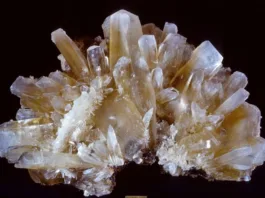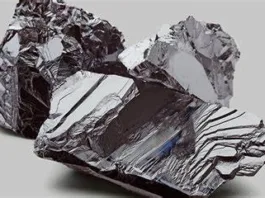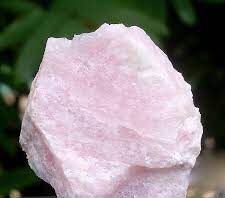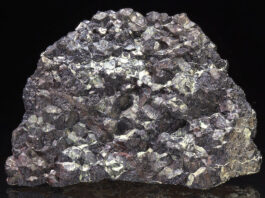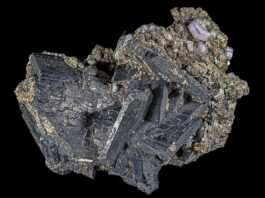Silver ore refers to natural deposits of silver-containing minerals that are mined and processed to extract silver metal. Silver is a precious metal known for its lustrous appearance, high thermal and electrical conductivity, and various industrial, technological, and ornamental uses. Silver has a long history of human use, dating back to ancient civilizations, and it continues to be valued for its unique properties and versatile applications.

In the introduction to silver ore, key points to cover could include:
- Definition of Silver Ore: Define silver ore as a natural deposit or rock that contains silver in economically recoverable quantities.
- Properties of Silver: Briefly describe the physical and chemical properties of silver, such as its silver-white color, high reflectivity, malleability, ductility, and thermal and electrical conductivity.
- Historical Uses of Silver: Highlight the historical uses of silver, including as a medium of exchange (money), jewelry, tableware, decorative arts, and in various industrial and technological applications.
- Importance of Silver: Discuss the significance of silver as a precious metal, its unique properties, and its value in different cultural, historical, and modern contexts.
- Occurrence of Silver Ore: Provide an overview of the geological settings where silver ore is found, including associations with other minerals, rocks, and ores.
- Significance of Silver Ore: Discuss the economic, social, and environmental significance of silver ore mining and processing, including its contribution to local and global economies, job creation, and potential environmental impacts.
- Overview of Silver Ore Deposits: Provide a brief introduction to the types of silver ore deposits, their geological characteristics, and global distribution.
- Future Prospects of Silver Ore: Highlight the potential future prospects, challenges, and trends in silver ore mining and processing, including technological advancements, market demand, and sustainability considerations.
This introduction can serve as a foundation for further discussions on specific topics related to silver ore, such as its minerals, geology, mining, extraction, processing, uses, and environmental considerations.
Contents
Silver Physical and Chemical Properties
Silver (Ag) is a metallic element with a number of unique physical and chemical properties, including:
- Luster: Silver has a brilliant, shiny appearance known as metallic luster. This makes it highly valued in jewelry and silverware.
- Ductility and malleability: Silver is highly ductile and malleable, meaning it can be drawn into thin wires and hammered into thin sheets without breaking. This property makes it useful in various applications, such as in electrical wiring and as a component in various alloys.
- Conductivity: Silver is an excellent conductor of electricity and heat, making it highly valuable in electrical and thermal applications. It has the highest electrical and thermal conductivity among all elements, making it ideal for use in electrical contacts, switches, and conductive coatings.
- Melting and boiling point: Silver has a relatively low melting point of 961.8°C (1763.2°F) and a boiling point of 2162°C (3924°F), which makes it easy to melt and cast into different shapes and forms.
- Density: Silver has a relatively high density of 10.5 g/cm³, which gives it a substantial weight and feel. This density makes it useful in various applications, such as in the manufacturing of coins and bullion.
- Chemical reactivity: Silver is a noble metal and is relatively unreactive with air and water at normal temperatures. However, it can tarnish or corrode when exposed to sulfur-containing compounds, which is why silver objects may develop a dark patina over time.
- Antibacterial properties: Silver has antimicrobial properties and is known for its ability to kill or inhibit the growth of bacteria, fungi, and other microorganisms. This makes it useful in medical and healthcare applications, such as in wound dressings, catheters, and other medical devices.
- Alloying ability: Silver can easily form alloys with other metals, which expands its range of applications. For example, sterling silver is a popular alloy of silver that contains copper, making it more durable and suitable for jewelry and silverware.
In summary, silver has a unique combination of physical and chemical properties that make it valuable in various applications, ranging from jewelry and silverware to electrical and industrial applications. Its luster, ductility, malleability, conductivity, melting and boiling point, density, chemical reactivity, antibacterial properties, and alloying ability are all important characteristics that contribute to its wide range of uses and applications in modern society.
Silver Minerals
Silver minerals are naturally occurring compounds or elements that contain silver as a major component. Silver minerals are typically found in silver ore deposits and can be extracted for their silver content. Some of the common silver minerals include:
- Native Silver: Native silver is silver in its pure elemental form and is often found in small quantities in silver ore deposits. It is known for its distinct silver-white color and metallic luster.
- Silver Sulfides: Silver sulfides are compounds of silver and sulfur. Examples of silver sulfides include argentite (Ag2S), which is one of the most common silver minerals, and acanthite (Ag2S), which is a polymorph of argentite with a different crystal structure.
- Silver Halides: Silver halides are compounds of silver and halogens (chlorine, bromine, or iodine). Examples of silver halides include chlorargyrite (AgCl), bromargyrite (AgBr), and iodargyrite (AgI), which are often found in association with other silver minerals.
- Silver Carbonates: Silver carbonates are compounds of silver and carbonate ions (CO3^2-). Examples of silver carbonates include cerargyrite (AgClCO3) and embolite (Ag(Cl,Br)CO3), which are typically found in oxidized silver ore deposits.
- Silver Sulfosalts: Silver sulfosalts are complex compounds of silver, sulfur, and other elements such as antimony, arsenic, or bismuth. Examples of silver sulfosalts include pyrargyrite (Ag3SbS3) and stephanite (Ag5SbS4), which are often found in hydrothermal veins associated with other sulfide minerals.
- Silver Tellurides: Silver tellurides are compounds of silver and tellurium. Examples of silver tellurides include hessite (Ag2Te) and sylvanite ((Ag,Au)2Te4), which are often found in telluride-rich gold and silver deposits.
- Silver Alloys: Silver can also occur as an alloy with other metals, such as copper, gold, or mercury. Examples of silver alloys include electrum (a natural alloy of silver and gold) and amalgam (a silver-mercury alloy).
Understanding the different silver minerals is important in the exploration, mining, and processing of silver ore, as they can affect the recovery methods and processing techniques used to extract silver from ore deposits.

Silver ore minerals
Silver ore minerals refer to the naturally occurring compounds or elements that contain silver as a major component and are typically found in silver ore deposits. Some of the common silver ore minerals include:
- Argentite (Ag2S): Argentite is one of the most common silver minerals and is a silver sulfide. It is typically found in hydrothermal vein deposits and is characterized by its dark gray to black color and metallic luster.
- Acantite (Ag2S): Acanthite is another silver sulfide mineral and is a polymorph of argentite with a different crystal structure. It is often found in association with other silver minerals in silver ore deposits.
- Chlorargyrite (AgCl): Chlorargyrite, also known as horn silver, is a silver halide mineral. It is typically found in oxidized silver ore deposits and is characterized by its white to gray color and waxy luster.
- Pyrargyrite (Ag3SbS3): Pyrargyrite, also known as ruby silver or dark red silver, is a silver sulfosalt mineral. It is often found in hydrothermal veins associated with other sulfide minerals and is characterized by its deep red color and metallic luster.
- Stephanite (Ag5SbS4): Stephanite is another silver sulfosalt mineral and is typically found in hydrothermal veins. It is characterized by its dark gray to black color and metallic luster.
- Tetrahedrite (Cu,Fe)12Sb4S13): Tetrahedrite, also known as gray copper or freibergite, is a complex sulfide mineral that can contain significant amounts of silver. It is typically found in polymetallic ore deposits and is characterized by its dark gray to black color and metallic luster.
- Electrum: Electrum is a natural alloy of silver and gold and can occur as a silver ore mineral. It is typically found in association with gold in gold-silver deposits and is characterized by its pale yellow to silvery color and metallic luster.
These are some of the common silver ore minerals that are found in various types of silver deposits around the world. Understanding the mineralogy of silver ores is important in the exploration, mining, and processing of silver, as it can impact the recovery methods and processing techniques used to extract silver from ore deposits.

Geology and Formation of Silver Ore
The geology and formation of silver ore deposits involve complex geological processes that result in the concentration of silver in specific rock formations or ore bodies. Here are some key aspects of the geology and formation of silver ore:
- Hydrothermal Processes: One of the most common processes for the formation of silver ore deposits is hydrothermal activity. Hydrothermal fluids, which are hot, mineral-rich fluids that circulate through cracks and fractures in the Earth’s crust, can deposit silver minerals as they cool and precipitate. Hydrothermal silver deposits are often associated with volcanic or geothermal activity and are found in areas with extensive faulting and fracturing.
- Magmatic Processes: Some silver ore deposits are associated with igneous rocks, such as granites or porphyry deposits. During the formation of igneous rocks, molten magma can trap and carry small amounts of silver minerals, which then crystallize as the magma cools and solidifies. Magmatic processes can result in the formation of silver-rich ore bodies, often in combination with other minerals, such as copper, lead, and zinc.
- Sedimentary Processes: Silver can also be deposited in sedimentary environments. For example, silver minerals can precipitate from seawater or groundwater and accumulate in sedimentary rocks, such as sandstones, shales, or limestone. Silver-rich sedimentary deposits are relatively rare compared to hydrothermal or magmatic deposits, but they can occur in specific geological settings.
- Metamorphic Processes: Silver can also be formed during the metamorphism of pre-existing rocks. Heat and pressure during metamorphism can cause chemical reactions that result in the formation of silver minerals from pre-existing minerals. Metamorphic silver deposits are typically associated with regional metamorphism, which occurs over large areas due to tectonic forces.
- Weathering and Secondary Enrichment: Weathering and erosion can also play a role in the formation of silver ore deposits. Primary silver minerals in rocks can be weathered and broken down, releasing silver into groundwater or surface water. The dissolved silver can then be transported and deposited in other locations, forming secondary enrichment zones where silver accumulates in higher concentrations.
The geology and formation of silver ore deposits are complex and can involve a combination of several geological processes. The specific geology and mineralogy of silver deposits vary widely depending on the deposit type, location, and geological history of the area. Understanding the geology and formation of silver ore is crucial for exploration, mining, and processing of silver deposits to optimize extraction methods and maximize recovery.

Mining and Extraction of Silver Ore
The mining and extraction of silver ore typically involve several stages, including exploration, mining, processing, and refining. Here’s an overview of the main steps involved in the mining and extraction of silver ore:
- Exploration: The first step in mining silver ore is the exploration of potential deposits. This involves geological surveys, mapping, and sampling to identify areas with high concentrations of silver minerals. Advanced technologies such as remote sensing, geophysical surveys, and geochemical analysis may also be used to identify potential silver deposits.
- Mine Development: Once a potential silver deposit is identified, the next step is mine development. This involves clearing the land, constructing access roads, and creating mine infrastructure, such as tunnels, shafts, and adits, for underground mines, or pits and benches for open-pit mines. Mine development also includes installation of mine safety and environmental protection measures.
- Mining Operations: The extraction of silver ore from the deposit can be done through various methods, depending on the type and location of the deposit. Common methods include underground mining, open-pit mining, and heap leaching. Underground mining involves tunneling into the deposit to access the silver-bearing rock, while open-pit mining involves removing the overlying soil and rock to expose the ore body. Heap leaching involves piling the ore on a heap and then applying chemicals to extract the silver through a leaching process.
- Ore Processing: Once the ore is extracted, it is typically transported to a processing plant for further treatment. Silver ore is often processed through crushing, grinding, and flotation to separate the silver-bearing minerals from the gangue rock. Additional processes such as gravity separation, cyanidation, or smelting may also be used, depending on the type and quality of the ore and the desired silver product.
- Refining: After the silver ore is processed, the extracted silver may need to undergo further refining to remove impurities and obtain high-quality silver. Refining methods may include smelting, electrorefining, or chemical processes, depending on the desired purity and end-use of the silver.
- Environmental and Safety Measures: Mining and extraction of silver ore involve environmental and safety considerations. Measures such as waste management, reclamation, and water treatment are often implemented to minimize the impact on the environment. Occupational health and safety measures, including ventilation, mine support, and emergency response plans, are also important to ensure the safety of mine workers.
- Marketing and Distribution: Once silver is extracted and refined, it is typically sold to various markets for different applications, such as jewelry, coins, industrial uses, and investment purposes. Marketing and distribution of silver may involve transportation, storage, and trading activities to ensure the silver reaches its intended markets.
The mining and extraction of silver ore require advanced technologies, careful planning, and adherence to environmental and safety regulations. Proper extraction and processing methods are critical to maximize silver recovery while minimizing environmental impacts and ensuring the safety of mine workers.

Processing and Beneficiation of Silver Ore
The processing and beneficiation of silver ore involve several steps to separate the silver-bearing minerals from the gangue rock and obtain high-quality silver. Here’s an overview of the main processes involved in the processing and beneficiation of silver ore:
- Crushing and Grinding: The silver ore is typically crushed and ground into smaller particles to facilitate further processing. Crushing and grinding may be done using jaw crushers, cone crushers, rod mills, or ball mills, depending on the size of the ore and the desired particle size.
- Flotation: Flotation is a common method used to separate silver minerals from the gangue rock. It involves adding chemicals, called collectors, to the slurry of crushed ore and water. The collectors selectively attach to the silver minerals, allowing them to be separated from the gangue rock by froth flotation. The froth containing the silver minerals is skimmed off and further processed.
- Gravity Separation: Gravity separation methods, such as jigging, shaking tables, or spiral concentrators, may also be used to separate silver minerals from gangue rock based on their differences in density. Gravity separation is particularly effective for coarser particles of silver ore.
- Cyanidation: Cyanidation is a commonly used method for processing silver ores that contain silver in combination with other minerals, such as gold. It involves treating the ore with a dilute solution of sodium cyanide, which reacts with the silver minerals to form a soluble silver cyanide complex. The silver can then be precipitated or recovered from the solution by various methods, such as zinc precipitation or electrowinning.
- Smelting: Smelting is a process used to extract silver from silver ore that is rich in silver sulfide minerals, such as argentite or galena. It involves heating the ore in a furnace with a reducing agent, such as coke or charcoal, which reacts with the silver sulfide minerals to form metallic silver. The molten silver is then collected and further processed to obtain high-quality silver.
- Refining: After the silver ore is processed and the silver is extracted, it may undergo further refining to remove impurities and obtain high-quality silver. Refining methods may include cupellation, electrolysis, or chemical processes, depending on the desired purity and end-use of the silver.
- Tailings Management: Tailings, the leftover materials from the ore processing, may contain residual silver and other minerals, as well as chemicals used in the processing. Proper management of tailings, including storage, containment, and environmental monitoring, is important to minimize the impact on the environment and ensure compliance with environmental regulations.
The processing and beneficiation of silver ore require careful consideration of the ore’s characteristics, desired end-products, and environmental regulations. Proper processing methods, including crushing, grinding, flotation, cyanidation, smelting, and refining, are critical to maximize silver recovery while minimizing environmental impacts and producing high-quality silver for various applications.

Global Distribution of Silver Ore
Silver ore deposits are found in various regions around the world, with different types of deposits occurring in different geological settings. Here’s a general overview of the global distribution of silver ore:
- Mexico: Mexico is one of the largest producers of silver in the world and has a long history of silver mining. The famous “Silver Belt” in Mexico, which includes the states of Zacatecas, Chihuahua, Durango, and San Luis Potosi, is known for its rich silver deposits. Other important silver-producing regions in Mexico include Sonora, Guerrero, and Jalisco.
- Peru: Peru is another major producer of silver, with significant silver ore deposits located in the central Andes Mountains. The Cerro de Pasco region in Peru is one of the oldest and largest silver mining districts in the world.
- China: China is one of the top producers of silver, with silver deposits occurring in various regions such as Inner Mongolia, Yunnan, and Xinjiang. China has been increasing its silver production in recent years to meet growing demand for industrial and investment purposes.
- Canada: Canada is also known for its silver deposits, particularly in the provinces of Ontario, British Columbia, and Yukon. The Cobalt region in Ontario, known as the “Silver Capital of Canada,” has historically been a major silver-producing area.
- United States: The United States has significant silver deposits, particularly in states such as Nevada, Idaho, Arizona, and Montana. The Coeur d’Alene district in Idaho is one of the largest silver-producing regions in the U.S.
- Bolivia: Bolivia is known for its rich silver deposits, particularly in the Potosi region, which has a long history of silver mining dating back to the colonial era.
- Other Regions: Silver ore deposits can also be found in other countries such as Australia, Russia, Argentina, Chile, Kazakhstan, and Poland, among others.
It’s important to note that the distribution of silver ore deposits can vary over time as new deposits are discovered, and mining technologies and economic factors evolve. Additionally, the grade and quality of silver ores can vary widely depending on the deposit, which can impact the economics of mining and processing.

Silver Ore Deposits
Silver ore deposits are typically formed through a variety of geological processes that result in the concentration of silver in specific locations. Here are some common types of silver ore deposits:
- Epithermal Deposits: Epithermal silver deposits are formed in volcanic regions and are associated with hot, acidic hydrothermal fluids that circulate near the Earth’s surface. These fluids carry silver and other minerals from deeper in the Earth’s crust, and when they come into contact with cooler rocks, they deposit silver and other minerals as veins or disseminations. Epithermal deposits can occur in a variety of host rocks, such as volcanic rocks, sedimentary rocks, or even in shallow marine environments.
- Polymetallic Vein Deposits: Polymetallic vein deposits are often associated with regional tectonic processes that result in the formation of faults and fractures in the Earth’s crust. These fractures serve as pathways for mineral-rich fluids, including silver, to flow and accumulate in veins within the rocks. Polymetallic vein deposits may contain a combination of silver, lead, zinc, copper, and other metals.
- Porphyry Deposits: Porphyry deposits are large, low-grade deposits that are typically associated with igneous rocks, specifically porphyritic intrusions. These deposits can contain significant amounts of silver as well as other metals such as copper, molybdenum, and gold. Porphyry deposits are typically formed in subduction zones where magma from the Earth’s mantle rises and interacts with overlying crustal rocks.
- Carbonate Replacement Deposits: Carbonate replacement deposits are formed through the replacement of carbonate rocks, such as limestone or dolomite, by metal-rich fluids. These deposits can contain significant amounts of silver as well as lead, zinc, and other metals. Carbonate replacement deposits are typically associated with sedimentary basins or areas of carbonate rocks that have been subjected to hydrothermal activity.
- Sedimentary Exhalative (SEDEX) Deposits: SEDEX deposits are formed through the precipitation of metal-rich minerals from hydrothermal fluids that are expelled from sedimentary rocks on the ocean floor. These deposits can contain silver along with lead, zinc, and other metals. SEDEX deposits are typically found in sedimentary basins or areas where volcanic activity is associated with sedimentary rocks.
- Placer Deposits: Placer deposits are formed by the accumulation of heavy minerals, including silver, in stream or river sediments. These deposits can be found in various geological settings and are typically formed through the erosion and transportation of primary silver deposits or other metal-rich rocks.
It’s important to note that silver ore deposits can have diverse geological characteristics, and the specific type of deposit can impact the mining and extraction methods used, as well as the economics of extracting silver from the ore. Different types of silver deposits may require different processing and beneficiation techniques to extract silver effectively.

Silver Occurrence
Silver occurs naturally in various forms and settings. Here are some common occurrences of silver:
- Native Silver: Silver can occur in its pure form as native silver, which is composed solely of silver atoms. Native silver is relatively rare and typically occurs in small quantities in various types of ore deposits, such as epithermal veins, polymetallic veins, and placer deposits.
- Silver Sulfides: Silver can also occur in the form of sulfide minerals, where it is combined with sulfur. Common silver sulfide minerals include argentite (Ag2S) and proustite (Ag3AsS3), among others. Silver sulfides are typically found in hydrothermal vein deposits and can also occur in association with other sulfide minerals, such as lead and zinc sulfides.
- Silver Halides: Silver can also occur in the form of halide minerals, where it is combined with halogen elements such as chlorine, bromine, or iodine. Common silver halide minerals include chlorargyrite (AgCl) and embolite (Ag(Cl,Br)). Silver halides are typically found in oxidized ore deposits and can also occur in association with other halide minerals.
- Silver-Copper Deposits: Silver can occur in copper deposits as a byproduct of copper mining. Copper ores often contain small amounts of silver, and silver can be extracted from copper ores during the copper refining process. Some examples of silver-copper deposits include the Kupferschiefer deposits in Poland and the porphyry copper deposits in Chile.
- Silver-Lead-Zinc Deposits: Silver can also occur in lead-zinc deposits as a byproduct of lead and zinc mining. Lead and zinc ores often contain small amounts of silver, and silver can be extracted from these ores during the lead and zinc refining process. Some examples of silver-lead-zinc deposits include the Broken Hill deposit in Australia and the Coeur d’Alene district in Idaho, USA.
- Environmental Sources: Silver can also occur in trace amounts in soil, water, and air as a result of natural weathering processes, volcanic emissions, and human activities such as mining, industrial processes, and use of silver-containing products. Silver can also occur in minerals associated with silver-rich mine tailings, waste rocks, and smelter emissions.
It’s important to note that the occurrence of silver can vary greatly depending on the specific geologic setting and deposit type. The occurrence of silver is typically associated with other minerals and elements, and the extraction of silver from ore deposits often involves complex processes to separate and refine the silver from other minerals and impurities.
Uses and Applications of Silver Ore
Silver has been used by humans for thousands of years due to its unique properties, and it continues to have a wide range of uses and applications today. Here are some common uses and applications of silver:
- Jewelry and Silverware: Silver has long been used to make jewelry and decorative items due to its lustrous appearance and malleability. Silver is often alloyed with other metals to create sterling silver, which is used to make silverware, flatware, and various types of jewelry.
- Coins and Bullion: Silver has been used as a medium of exchange in the form of coins for many centuries. Silver coins have been minted by many countries throughout history and are still produced today as collectible coins or investment-grade bullion. Silver bullion bars are also commonly used as a store of value and investment.
- Electrical and Electronics: Silver is an excellent conductor of electricity and is used in a wide range of electrical and electronic applications. It is used in electrical contacts, switches, and connectors, as well as in printed circuit boards and other electronic components. Silver’s high thermal conductivity also makes it useful in thermal management applications, such as in heat sinks for electronic devices.
- Photography: Silver has been used in traditional photography as the light-sensitive material in photographic films and papers. While digital photography has largely replaced traditional film-based photography, silver is still used in specialty photographic applications and in some medical imaging technologies.
- Medical and Healthcare: Silver has antimicrobial properties and has been used for various medical and healthcare applications. It is used in wound dressings, catheters, and other medical devices to help prevent infection. Silver compounds are also used in some medications for their antimicrobial properties.
- Industrial Applications: Silver is used in various industrial applications, such as in the production of mirrors, reflective coatings, and solar panels. It is also used in the production of catalysts for chemical reactions and in the manufacture of specialized alloys and materials.
- Other Applications: Silver is used in other applications, such as in the production of silver nanoparticles for use in electronics, sensors, and medical applications. It is also used in some decorative and artistic applications, as well as in the automotive industry for coatings and plating.
It’s important to note that the uses and applications of silver can vary depending on the specific form of silver, such as silver ore, silver compounds, or silver products, as well as the technological advancements and market demand. Silver’s unique properties make it a valuable and versatile metal with a wide range of uses in various industries and applications.

Conclusion
In conclusion, silver ore is a valuable natural resource that is mined, processed, and used for various applications worldwide. Silver minerals, such as native silver, silver sulfides, and silver-bearing ores, are found in different geological formations and deposits around the world. Silver has been used by humans for thousands of years due to its unique properties, including its lustrous appearance, high electrical and thermal conductivity, and antimicrobial properties.
The mining and extraction of silver ore involve various methods, such as underground mining, open-pit mining, and heap leaching, depending on the ore deposit characteristics and economic considerations. Once extracted, silver ore is processed and beneficiated to obtain high-quality silver concentrates, which are then used in a wide range of applications.
Silver has numerous uses and applications, including in jewelry and silverware, coins and bullion, electrical and electronics, photography, medical and healthcare, industrial applications, and others. Its unique properties make it highly sought after in various industries, from technology and healthcare to automotive and decorative applications.
The global distribution of silver ore deposits is widespread, with major producing countries including Mexico, Peru, China, Australia, and Russia, among others. However, the availability and production of silver ore can be influenced by factors such as economic conditions, technological advancements, environmental regulations, and market demand.
In summary, silver ore is a valuable natural resource with diverse applications and global distribution. Its unique properties and versatile uses make it an important metal in various industries and applications, and its extraction, processing, and utilization contribute to economic development and human advancement.

